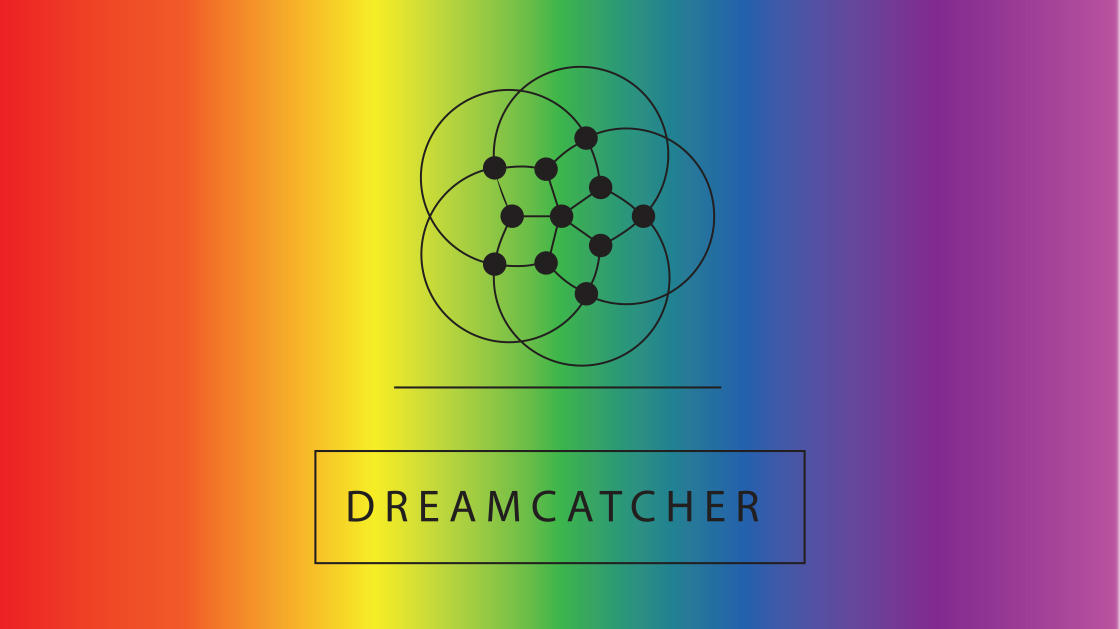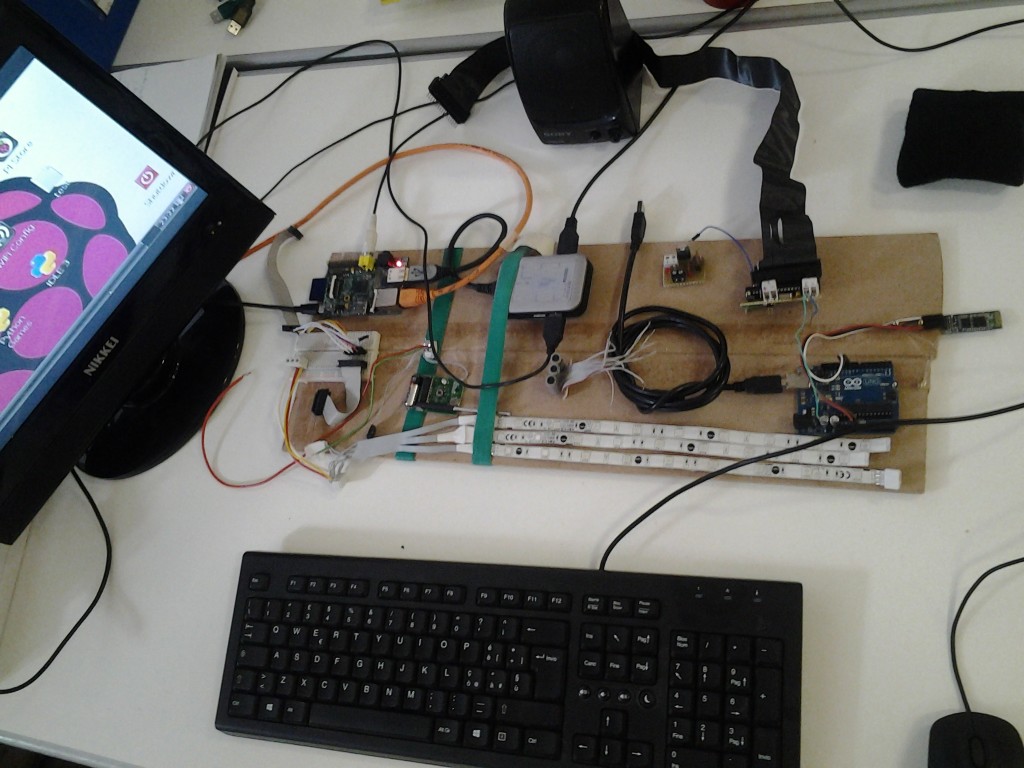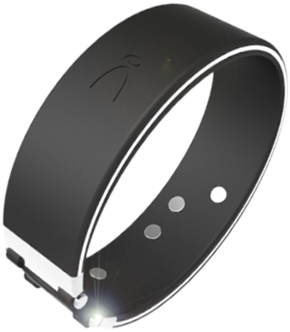Siamo all’interno della Ro Technology, start up innovativa dove si incontrano professionisti, designer e ingegneri. Tra questi anche Gabriele Burnelli e Massimo Supino, due dei cinque inventori del Dreamcatcher rimasti nel team. “Il Dreamcather è nato nel weekend del 19 marzo 2014 quando la start up Codemotion ha dato il via all’hackathon, gara di appassionati che si incontrano e si sfidano nella realizzazione di un progetto innovativo, che devono sviluppare in 48 ore. Quest’anno è stata organizzata presso il Tempio di Adriano, eravamo circa dieci gruppi. Noi cinque ci siamo conosciuti tutti quella sera.” Così Gabriele mi parla del primo incontro e della fase embrionale del progetto. “Abbiamo pensato di proporre un sistema – prosegue – che serva a controllare e interagire con il sonno per migliorarlo. Il gruppo originariamente era formato da persone con competenze diverse: due designer, un esperto di software, un conceptual designer e un ingegnere elettronico. Grazie al Dreamcatcher, progettato prima su carta e poi con gli strumenti elettronici messi a disposizione, abbiamo vinto il premio speciale ‘Asset Camera’ che consisteva nella possibilità di partecipare alla Maker Faire di Roma 2014 senza passare per le selezioni. Da marzo a ottobre abbiamo portato avanti le idee che avevamo concepito per prepararle ad una propulsione da mercato. Ci siamo posti l’obiettivo di sviluppare il sistema fino a capirne l’utilità a livello sociale e medicale e poi capire a livello energetico ed economico quanto sarebbe costata la sua produzione sul mercato.”
Cos’è allora il Dreamcather? Dall’inglese, vuol dire acchiappasogni, ma non è né il tradizionale oggetto indiano che si mette sulla porta in attesa di una folata di vento, né il film del 2003 tratto dal romanzo di Stephen King. “Dreamcatcher – continua Gabriele – è un nome allusivo al fatto che lavora con il sonno. Il sistema tuttavia non è in grado di capire cosa sta sognando la persona ma raccoglie dei dati biometrici, tramite un braccialetto già presente sul mercato, e capisce cosa sta succedendo durante la notte, se si sta in fase rem, se si sta sognando, se si ci sta svegliando. Attraverso poi dei sistemi che sono la cromoterapia e i binaural beats è capace di migliorare il sonno della persona. Per quanto riguarda la cromoterapia abbiamo pensato di fare accendere delle luci all’interno della stanza da letto, tecnica già usata negli ospedali, in quanto l’occhio umano riesce a vedere anche attraverso la palpebra. I binaural beats invece sono delle frequenze audio particolari, pubblicate già su vari siti noti nel mondo scientifico, che dovrebbero aiutare nel rilassamento e nel risveglio.”
Per parlare di questo strumento e capirne la portata, è necessario partire dall’assunto che le persone sono a proprio agio più in casa propria che in una stanza d’ospedale. Anzi, molte rifiutano di sottoporsi a controlli proprio per questo motivo. Ecco perché parlare di un apparecchio dal significativo valore medico che può essere tranquillamente utilizzato dormendo sul proprio materasso. Gabriele ci spiega allora come dovrebbe funzionare il Dreamcatcher: “Il target di persone a cui era indirizzato al momento della nascita erano le persone con problemi di sonno e con il desiderio di controllarlo con uno strumento innovativo. Poi ci siamo resi conto che c’erano problemi di trattamento del dato e abbiamo deciso di affrontarli in un secondo momento, occupandoci prettamente più dell’aspetto tecnico e dell’informazione. I dati raccolti dovrebbero essere trasmessi su internet dove vengono analizzati da un’equipe di medici, che poi deve fornire una cura da applicare alla persona.”
Parlando propriamente dell’aspetto medico, componente fondamentale di un progetto di questo tipo, Gabriele ci rassicura: “Dietro il progetto, nel tempo trascorso tra la gara e il Maker Faire, abbiamo contattato diversi medici di molti ospedali, professionisti dell’Istituto Superiore di Sanità, o che lavorano con le squadre di calcio di Serie A, che ci hanno dato consigli e fatto riflettere su diversi fattori, per rendere lo strumento utilizzabile ed efficace. Siamo in contatto anche con ricercatori del CNR e del Campus Biomedico, che stanno lavorando a sensori medicali in grado di essere usati con un oggetto come il nostro. Alcuni medici ci hanno anche chiesto di collegare il Dreamcatcher con strumenti già esistenti. La cosa bella è che abbiamo trovato moltissime persone che si sono offerte di sperimentare il dispositivo. La nostra idea è che il sistema sia più pratico e comodo possibile, per questo abbiamo pensato di usare solo il braccialetto, ma per un’analisi più accurata ci sono moltissimi sensori già in commercio, che possono essere collegati. Lo scopo è quello di vendere l’oggetto non solo a chi ha problemi di sonno ma, sfruttando il sistema di autodiagnosi, anche a coloro che hanno problemi fisici più generici.”
“Al momento abbiamo fatto buona parte del lavoro tecnico, informatico ed elettronico, realizzando un prototipo plastico. La Ro Technology ci sta supportando in diverse parti del sistema, assieme ad un partner di Napoli, che invece si è occupato di tutta la parte documentale e di trattamento dei dati. Stiamo facendo delle ricerche di mercato per andare incontro ad alcuni professionisti che ci stanno chiedendo integrazioni di sistema. Finita questa ricerca ci stiamo muovendo nel cercare persone competenti che ci possano aiutare a portare a termine le parti che mancano.” Insomma un bel po’ di lavoro per questi ragazzi, che d’altronde è quello richiesto per un sistema che non è solo l’oggettino per abbellire la casa, ma che aiuterà a tutti gli effetti chi ha problemi di sonno. “Il sistema sarà adattato alla persona che lo deve utilizzare – continua a spiegarmi Gabriele – e una volta completata la parte tecnica ci sarà un lungo periodo di test, per raccogliere i dati e fare una nostra analisi.”
Parlando di tecnologia ad alti livelli, è lecito chiedere se i tanto comuni smartphone saranno parte integrante del sistema: “L’interazione con lo smartphone è prevista ma non è necessaria e consentirà l’utilizzo di funzionalità più avanzate, come ad esempio selezionando la modalità in cui si vuole dormire per poi vedere alla fine della notte il risultato del tracciato del sonno. Per facilitarci la strada abbiamo pensato di partire da app già progettate per questo scopo, tramite le quali si possono vedere varie statistiche, ma ne svilupperemo sicuramente anche una nostra ex novo. Il sistema dovrebbe produrre un tracciato proveniente dai vari sensori che può essere letto da un medico specialistico, che sarà colui che poi fornirà la diagnosi, ma anche dalla persona e permettergli di capire cosa è accaduto.”
Ma allora come sarà presentato di Dreamcatcher? “Il dispositivo la sera della gara era stato progettato con una forma cilindrica con un profilo leggermente ondulato, simile a quella di un vaso, con dei fori laterali predisposti per la diffusione delle tracce audio emesse delle casse interne e con la parte superiore disegnata per ospitare delle strisce di LED multicolore (sempre facendo riferimento alla cromoterapia e ai binaural beats ndr). Successivamente, analizzando il sistema, abbiamo pensato che renderlo simile a un oggetto comune poteva essere meglio e poteva renderlo più appetibile sul mercato. Per questo abbiamo pensato alla sveglia.”
Insomma, il progetto c’è, è in fase di test, di ultimazioni, di ricerche e di design. Aspettate perché ne sentirete parlare ancora. E noi di The WalkMan saremo lì.
[divider]ENGLISH VERSION[/divider]
We are in the Ro Technology, an innovative start-up where you can meet experts, designers and engineers. Among these there were Gabriele Burnelli and Massimo Supino, two of the five inventors of Dreamcatcher left in the team. “Dreamcatcher was born on the weekend of March 19, 2014 when the start-up Codemotion opened the door to the Hackathon, that is a race of experts who meet and challenge each other in the realization of an innovative project and they must develop it in 48 hours. This year it was held at the Temple of Hadrian and we were about ten groups. The five of us, we met that evening.” In this way Gabriele said to us on their first meeting and on the embryonic stage of the project. “We have decided to offer a system –continues- which serves to control and interact with the sleep in order to improve it. People with different skills originally formed the group: two designers, a software expert, a conceptual designer and an electrical engineer. Thanks to Dreamcatcher, designed on paper first, and then with electronic tools provide, we won the special prize ‘Asset Camera’, which was the possibility of participating in the Maker Faire in Rome in 2014 without going through selections. From March to October we have continued to take ideas forward, the ideas that we had planned to pitch in the market. We have set ourselves the goal of developing the system to understand the benefits at the social and medical level and then figure out in terms of energy and cost how much the cost of its production would cost on the market.”
What is then the Dreamcatcher? In English basically it means (what) catches dreams, but is neither the traditional Indian object that you put on the door waiting for a gust of wind, nor the 2003 film based on the novel by Stephen King. “Dreamcatcher –continues Gabriele- is a name that alluding to the fact that it works with sleep. The system, however, is not able to understand what the person is dreaming but it collects biometric data, though a bracelet, already on the market, and understands what is going on during the night, if you are in REM sleep, if you are dreaming or if you are waking up. Then through systems that are the chromotherapy and binaural beats it is able to improve the person’s sleep. Regarding the chromotherapy we thought to turn on the lights in the bedroom, technique already used in hospitals, due to the fact that the human eye can also see through the eyelid. The binaural beats instead are particular audio frequencies, already published on different sites known in the scientific world, which should help in the relaxation and awakening.”
Talking about this tool and understanding its potential is necessary to start from the premise that people are more at tease in their own home than in a hospital room. Indeed, many of them refuse to submit to checks just for this reason. That is why talk about an appliance, from a significant medical value, can be safely used sleeping on their mattress. Gabriele explains to me, then, how the Dreamcatcher should work: “The target of people who had addressed at the time of its birth were people with sleep problems and that have the desire to control it with an innovative tool. Then we realized that there were problems with the data and so we decided to deal with the problem at a later stage, dealing more strictly with the technical and information point. The collected data should be transmitted on the Internet where they are analyzed by a team of doctors, who then must provide a cure to be applied to the person.”
Talking about properly the medical aspect, a fundamental component of a project of this type, Gabriele reassures us: “Behind the project, in the time between the Race and the Maker Faire, we contacted several doctors of different hospitals, experts of the Istituto Superiore di Sanità (National Institute of Health), or ones who working with the football team of Serie A (Italian Footballs League), they gave us advice and they made us reflect on several factors, to make the instrument usable and effective. We are also in contact with researchers from the Italian CNR (National Research Council) and from the Biomedical Campus, who are working on medical sensors that can be used with an object such as ours. Some doctors have also asked us to connect the Dreamcatcher with existing tools. The great thing is that we found many people who have offered to test our device. Our idea is that the system must be as more convenient and comfortable as possible, for this reason we decided to use only the bracelet, but for a more accurate analysis there are many sensors already on the market, that can be connected. The purpose is to sell the object not only to those who have sleep problems, but taking advantage of the self-diagnosis system, even to those who have more generic physical problems.”
“At the moment we did most of the technical, computer and electronic work, crating a plastic prototype. The Ro Technology is supporting us in different parts of the system, together with a partner of Naples, which instead has handled all the administrative and data processing part. We are doing market research to meet some experts who are asking for system integration. After the end of this research, we are moving in seeking competent people who can help us in complete the parts that are missing.” In other words a lot of work for these guys, which, moreover, is that required for a system that is not only the small object to decorate the house, but it will help, effectively, those who have sleep problems. “The system will be adapted to the person who has to use it – continues Gabriele- and once completed the technical part, there will be a long period of testing, to collect data and make our analysis.”
To speak of technology at high levels, it is legitimate to ask if the so common smartphone will be an integral part of the system: “The integration with the smartphone is expected but not required and will allow the use of more advanced features, such as selecting the mode in which you want to sleep only to see at the end of the night the result of the track of the sleep. To facilitate our way we thought of starting from app already designed for this purpose, through which you can see various statistics, but we certainly develop our own from scratch. The system should produce a path from the various sensors that can be read by a specialist doctor, who then provide the diagnosis, but also by the person and let its know what happened.”
But then how will be presented to Dreamcatcher? “The device in the evening of the race was designed with a cylindrical shape with a slightly wavy profile, similar to the one of a vase, with lateral flowers prepared for the dissemination of audio tracks issued from the internal speakers and with the top designed to host some multi-colored LED strips (always referring to the chromotherapy and binaural beats Ed). Gradually, analyzing the system, we thought that make it similar to a common object could be better and could make it more attractive on the market. For this reason we thought the alarm clock shape.”
Finally, there is a project and it is in the testing phase, we are finalizing it, in terms of research and design. You just have to wait, because you will hear about yet and The WalkMan will be there.
Traduzione a cura di Clarissa Candellero







